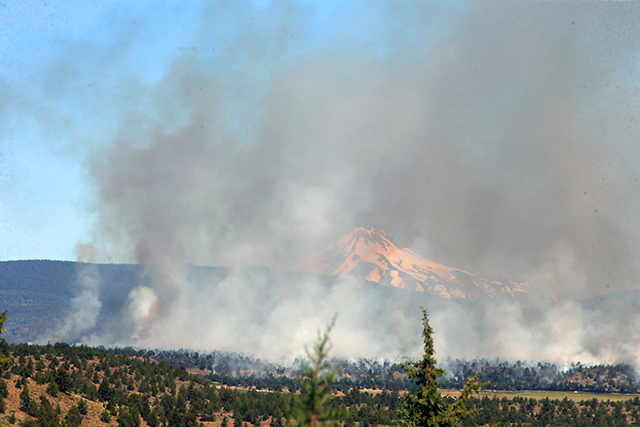Raw milk
Published 4:00 am Sunday, December 18, 2005
Billie and Dave Johnson spent two fruitless years trying to make it as a small commercial dairy, amassing a herd of 60 milk cows on a windswept and largely treeless parcel outside Prineville.
They threw in the towel earlier this year, overwhelmed by too much work for too little return.
Two months ago, they started over as a private dairy producing unpasteurized milk for a select number of customers willing to buy a share in the farm and pay a monthly fee – an arrangement referred to as herd-sharing.
The decision has put them in the middle of a growing debate about whether people should be able to provide raw milk to a growing number of customers who prefer unpasteurized milk. Those customers and other raw-milk proponents say they prefer the taste of raw milk, which, unlike its commercial counterpart, has not been heated to kill potentially harmful bacteria.
Oregon made it illegal for dairies to market and sell raw milk in 1997 after a pair of E. coli outbreaks were linked to raw-milk dairies in Tigard and Halsey. On Wednesday, health officials in Clark County, Wash., shut down a Vancouver-area raw-milk dairy after it was linked to an E. coli outbreak that sickened eight children – four of them seriously.
But Oregon law does not address herd-share businesses like Johnson’s dairy. And raw-milk supporters say more people are using the loophole to access unpasteurized milk that essentially goes straight from the cow to the bottle.
Despite health warnings, customers are willing to pay a premium for the product.
In demand
Johnson’s customers, many of whom live in Bend, pay as much as $24 a month to have a gallon of milk delivered every week. Those customers and other raw-milk proponents, including Johnson, say that raw milk not only tastes better but is also healthier for them because it contains nutrients, including beneficial microbes that aid digestion, that are lost in the pasteurization process.
But the U.S. Food and Drug Administration and state regulators strongly discourage consumption of unprocessed milk because of the possibility of disease.
Because much of the raw-milk trade happens below industry and regulatory radar, there is no firm count on the number of raw-milk drinkers or raw-milk dairies.
But raw-milk advocates, who have their own lobbying group in Washington, D.C., say the market for raw milk appears to be growing.
Johnson’s business, Windy Acres Dairy Farm, has seen its list of customers grow from roughly a dozen households to more than 30 since October when Johnson bought a pair of milk cows and a customer list from a small dairy farmer in Bend.
Johnson is delivering about 40 gallons per week to Bend. She thinks that number could rise to as much as 100 gallons in the next year.
Johnson, who doesn’t advertise her business, said she averages about one or two inquiries a week from potential customers.
”The people who want it come to me; I don’t go to them,” said Johnson, who keeps a gallon of raw milk in her kitchen refrigerator.
Health food or health hazard?
A grandmother of four who up grew working on her father’s cattle ranch in Monument, Ore., Johnson said fears about raw milk are overblown and the dangers fabricated.
”It’s a hoax … I was raised on it,” Johnson said during a recent interview in her home, decorated with framed pictures of farm-life scenes.
Other supporters say that raw milk has been unfairly targeted by the government and the commercial dairy industry.
”They realize this is a small movement,” said Sally Fallon, president of Weston A. Price Foundation in Washington, D.C. ”But the (dairy) industry is propped up with subsidies. It’s truly an industry in trouble. And they realize that if this movement gets out of hand, raw milk is a real threat to them.”
The foundation advocates healthier living through diet changes, such as the elimination of processed foods. It also is an information conduit for raw-milk drinkers and producers, providing links and phone numbers for consumers and sample herd-share agreements for producers to use as templates.
Johnson, whose business was certified as a Grade A commercial dairy before going unpasteurized, said the government would be better off regulating and inspecting small dairies that want to serve raw milk to their customers. She said she plans to invite state inspectors back to her operation and is currently looking for a lab that will test her milk for contamination.
”If there is something wrong with our milk, we want to know; we’re drinking it, too,” said Johnson, who milks her small herd every day at 6 a.m.
Each morning and again each night, the cows file into a metal-sided barn with six milking pens astride a waist-deep concrete pit that runs through the center of the room. Johnson leads the cows into the pens where they munch on grain that is fed through a PVC tube while she slips a milking device onto their undersides.
The whole process takes about an hour and produces about 60 gallons per day. That’s more than Johnson can use for her business, so the excess milk is fed to a pair of pigs and a herd of calves.
It’s hard work, especially in the chill December air.
A cold spell last week knocked out a heating lamp in the cow’s trough and the water froze solid. The pig slop, a mix of milk and grains, had also gone stiff.
Wearing a fleece jacket with the logo from the 2005 Wrangler Rodeo Finals and hat pulled tight on her ears, Johnson jabbed at the frozen block with a shovel, eventually carving out an ice cream-like scoop of the pink pig feed, which she heaved over the side of the corrugated metal pen.
State regulators in Oregon said they haven’t decided yet how to deal with businesses like Windy Acres.
Under state law, commercial dairies are prohibited from distributing raw milk. The only exception is for small operations with three cows or less, which are permitted to sell raw milk on-site but cannot advertise sales or ship off the premises.
Herd shares, or condominium cows, are an attempt to bypass those regulations by allowing the customer to purchase the cow rather than the milk. The approach has not yet been challenged by food-safety regulators in Oregon.
The Oregon Dairy Farmers Association strongly opposes the practice, said Jim Krahn, executive director.
He said the Portland-based association, which represents 340 commercial dairies across the state, is concerned about the possibility of outbreaks like the one that happened last week in Washington and will try to shut down herd-share dairies in Oregon.
”From a food-safety perspective, these dairies are not regulated in any way, shape or form,” said Krahn, who grew up on a Wisconsin dairy drinking raw milk. ”That poses a huge human health risk to people who consume that product.”
Despite his own experience, Krahn said he would never allow his family to drink raw milk.
”I have eight grandchildren and I would be irate if any one of them drank raw milk,” he said.
Proponents acknowledge that herd-sharing is designed to frustrate bans on raw-milk sales.
”Herd-sharing is a stratagem for getting raw milk to the consumer where it is illegal to sell from a farm,” said the Price Foundation’s Fallon.
Under the microscope
The Oregon Department of Agriculture doesn’t have an official position on herd-sharing, said Ron McKay, the department’s food and safety division administrator.
The department recently asked the state Attorney General’s Office to review the law and provide an informal opinion on the matter, McKay said.
However, he said the department’s position on drinking raw milk is clear.
”I can say that that we have always not supported the consumption of raw milk and that isn’t changing,” McKay said. ”The potential for illness or diseases through raw milk is there. It doesn’t mean every glass of milk is contaminated. But the potential is there and pasteurization controls that.”
But until the department has a chance to review the attorney general’s opinion, McKay said it isn’t going to take a stand on herd-sharing.
Either way, McKay said the recent E. coli outbreak has added an urgency to resolve the herd-sharing issue in Oregon.
”It’s an issue that’s coming up all across the country,” he said. ”I don’t want to say it’s been a big thing here. But it’s something we need to have a position on,” he said.
In Washington, the state permits raw-milk dairies to market and sell their product to the general public. But dairies must register with the state and submit to monthly inspections. Producers also must label raw milk with a warning sticker.
Recently, Washington regulators began cracking down on so-called micro dairies, including herd shares, that have side-stepped or disregarded the rules.
The dairy linked to the E. coli outbreak was one of the producers that had received letters from the state requesting that it register, according to an article that appeared last week in the The (Vancouver) Columbian.
Raw-milk advocates, however, say the dairy industry has hidden the product’s benefits from the general public.
”What we’re attempting to do is counter all the misinformation that the food industry puts out there, including the dairy industry, because there is so much better nutrition in raw milk than in pasteurized,” said Rebecca Wagner, a Powell Butte resident and head of the Central Oregon chapter of the Price Foundation who buys milk from Johnson’s dairy.
A retired sales manager, Wagner taught nutrition classes in Portland before moving to Powell Butte in 2004 to be closer to her grandchildren.
She said raw milk is just one component of a larger push to get people away from mass-produced foods.
”Basically, we are what we eat,” she said. ”It’s an old tried-and-true cliche, but we can’t be anything else.”
Bend chiropractor Jim Neilson also is a member of Johnson’s herd-share cooperative and said he recommends the raw milk to his patients for what he said are its health benefits.
Neilson said he was shocked to hear about the E. coli outbreak in Washington. Still, he said he has no plans to stop drinking raw milk, which is part of a natural food diet that he and his wife have been on for the past two years. They also feed it to their 20-month-old daughter, he said.
”I think our whole family has thrived on raw milk,” Neilson said.
Making ends meet
Dairy farmer Johnson sees another benefit: the survival of small dairies.
As farm subsidies are phased out, it’s harder for small dairies like Windy Acres to make ends meet, Johnson said.
As a commercial operation, Windy Acres was fetching between $14 and $16 per 100 pounds of milk – roughly $1.16 to $1.33 per gallon.
That was barely enough to pay the bills, said Johnson who, with her husband, invested $210,000 in the equipment for the commercial dairy.
By contrast, customers pay a monthly fee that is the equivalent $4 per gallon per week to pick up milk at Johnson’s farm. Those who have it delivered pay the equivalent of about $6 per gallon.
Johnson said she is using the same equipment and the same methods she used as a Grade A commercial dairy. But she is doing less work and with a smaller herd – roughly eight animals versus 60 cows – and realizing greater returns.
She said the government needs to work with farmers like her to maintain these small, profitable operations.
”They need to give the farmer the benefit of the doubt,” Johnson said. ”If you’re doing everything you can do to keep (the milk) safe, you should be allowed to exist.”






